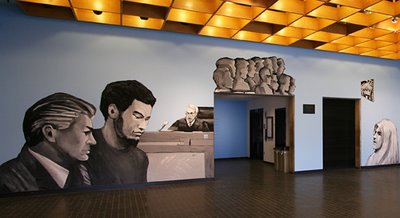Walid Raad

Walid Raad’s exhibit “We Can Make Rain But No One Came To Ask” at Brown University’s Bell Gallery, as I write in my review,
feels like a Borgesian detective story in which truth is elusive, and cities themselves shiver with post-traumatic stress disorder.Read the rest here.
For several years, the Lebanese-born New York-based artist has made art about the Lebanese Civil War of 1975 to 1991. This installation, Raad writes, focuses on a single car bombing in Beirut in 1986. The gallery is filled with five long tables, with 44 sheets of paper laid atop them like evidence. A fractured, impressionistic 17-minute video projected on a wall of the gallery seems to cover some of the same territory.
“My photographs [of Beirut] began to manifest colors and lines that were, at times, significantly different from the ones available to my eyes,” Raad writes in a group of pages that depict buildings mirrored, turned upside down, cut-up, and blurred. “I came to believe that something in . . . the time and space of the [bombed] neighborhood may have been affected not only by the 1986 detonation but also by every other war, skirmish, and assault in Lebanon since 1975 . . . I decided to print my photographs even if I still doubted what I was seeing in them.”
Walid Raad, “We Can Make Rain But No One Came To Ask,” Bell Gallery, Brown University, 64 College St., Providence, April 10 to May 25, 2008.
Pictured: “I Feel A Great Desire to Meet The Masses Once Again,” which a sign says was painted by Elly Boueri at Raad’s request. Supposedly.






0 Comments:
Post a Comment
<< Home